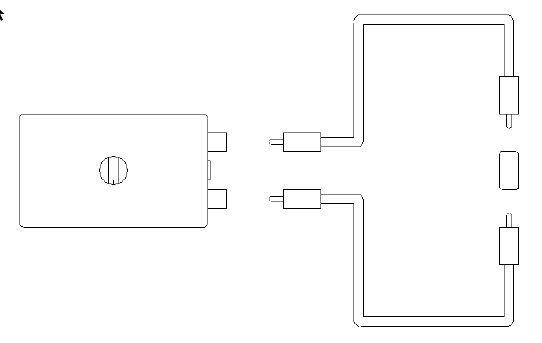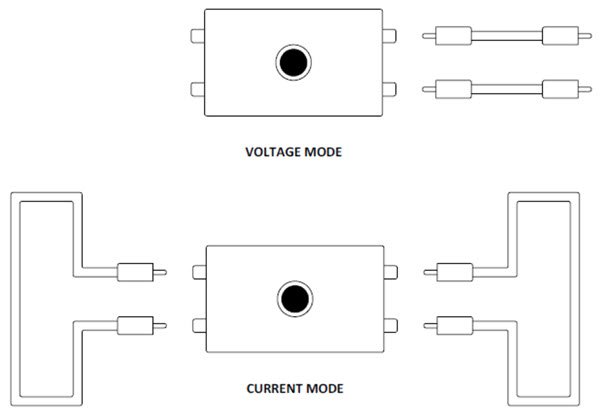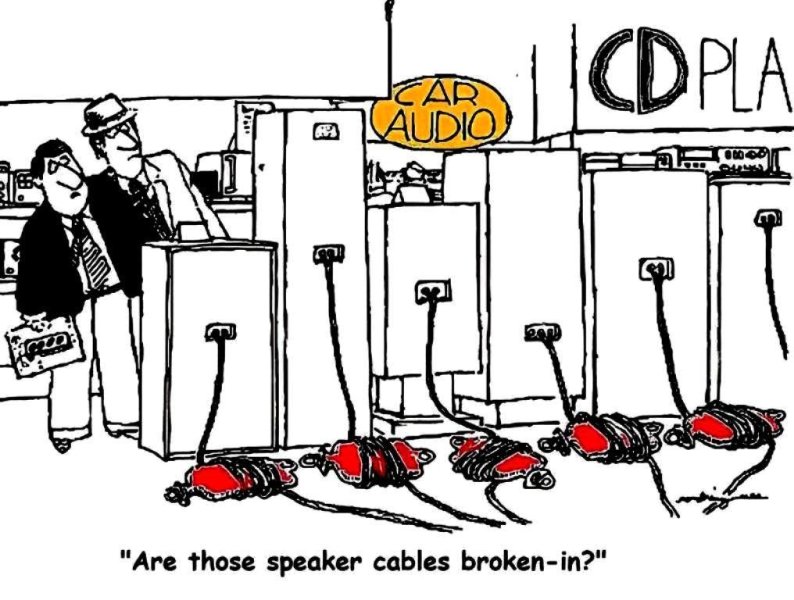I have heard the effect. I borrowed an Audio Dharma. The before and after on a DIY interconnect was obvious. The only problem was the after was worse sounding than the before! I'm simply saying that this Frybaby3 toy does next to nothing.
Cable Burn-in Devices - Looking for Recommendations
- Thread starter Jaguar
- Start date
You are using an out of date browser. It may not display this or other websites correctly.
You should upgrade or use an alternative browser.
You should upgrade or use an alternative browser.
I haven't tried a cable cooker. When I get a new cable I use an Isotek System Burn in Disk once a day for a week and then once a week for a few weeks thereafter. Otherwise, I just let the cable burn in as I play music
Frybaby, Frycorder, and Audioharma Cable Cooker (I have the "Anniversary" version) have all worked for me to some extent on cables but the Audioharma results in a bigger audible improvement compared with the Hagerman products and any system burn-in disc I've tried. I have for example taken a power cable that has been in constant use for 2+ years including several sessions on the Frycorder and half a dozen passes with a system burn-in disc, put it on the Cable Cooker for four (4) days and realized a clear audible (15%-20% est.) improvement in clarity and articulation when I returned it to the system.
FYI:

"I had long been of the opinion that playtime with music is the best burn-in process for any cable. I'm quite sure now that ain't true. It's a good second, certainly better than what you'll hear from a cable fresh out of the box, but my ears tell me it doesn't finish the job. For proof of that assertion, take a cable that you've been using for months, give it some time on the Audiodharma Cable Cooker, then listen and hear for your self.
Given adequate time on the Cooker, a cable comes out of the process with a flatter, more linear frequency response, and a more acoustic sound. In the samples I put through the process, that meant more midband, to a lesser degree more bass, and a wayward treble brought into the fold. This was the overt impact. A host of secondary areas benefited, i.e., smoother dynamic transitions, improved definition, and tone color. The Audiodharma Cable Cooker is demonstrably excellent at what it does and the results are very natural sounding".
FYI:

"I had long been of the opinion that playtime with music is the best burn-in process for any cable. I'm quite sure now that ain't true. It's a good second, certainly better than what you'll hear from a cable fresh out of the box, but my ears tell me it doesn't finish the job. For proof of that assertion, take a cable that you've been using for months, give it some time on the Audiodharma Cable Cooker, then listen and hear for your self.
Given adequate time on the Cooker, a cable comes out of the process with a flatter, more linear frequency response, and a more acoustic sound. In the samples I put through the process, that meant more midband, to a lesser degree more bass, and a wayward treble brought into the fold. This was the overt impact. A host of secondary areas benefited, i.e., smoother dynamic transitions, improved definition, and tone color. The Audiodharma Cable Cooker is demonstrably excellent at what it does and the results are very natural sounding".
Last edited:
I think there's a problem with the presumption that "burn in" on a high current device gets you to the same endpoint at which you'd arrive over a much longer period of time by simply "listening to music". I don't have any reason to believe that 1000s of hours of ordinary phono or line level current vs 10s of hours of unusually high current di/dt transients produces the same result. And I certainly don't presume that the result of high power burn in produces an audibly improved difference. An audible difference, yes. But an improvement, maybe. A degradation of sound quality, maybe as well.
Speaker cables will burn in with the current from the amp. The I/C cables will not. A much higher current is needed to do the job. I used to run my I/C cables through a old receiver speaker terminals with a sandbar resistor. It usually takes about a week to complete the process.
I can endorse that the AudioDharma Cable cooker works really well for burning in new cables. And its great to run your cables through every 6 months or so to keep them at their peak. I have not tried many other burn in products so can't compare to other stuff.
Great thread - answers the questions of the benefits and performance differences at different price points. Guess I’m getting the Audio Dharma.
I was surprised that cable cooking is recommended beyond the initial cable break in, that the manufacturer recommends periodic reconditioning of cables for tuneups.
I’m amused to think of Mike L fire hose cables being regularly moved to cook - that’ll be a workout
I was surprised that cable cooking is recommended beyond the initial cable break in, that the manufacturer recommends periodic reconditioning of cables for tuneups.
I’m amused to think of Mike L fire hose cables being regularly moved to cook - that’ll be a workout
Perhaps a dumb idea, but why not put inline with the refrigerator. Pretty good current demand, current changes periodically. And, I don't have to run all the equipment 24/7.
Thoughts?
Thoughts?
I used to do this to burn in power cables, kept them plugged in for a week or two. It works well, each time the refrigerator kicks in there is a large current inrush that is excellent for conditioning cables, and it draws ssignificant current as well. Something like a Cable Cooker works differently, and the results sound different.Perhaps a dumb idea, but why not put inline with the refrigerator. Pretty good current demand, current changes periodically. And, I don't have to run all the equipment 24/7.
Thoughts?
Yep, patience / your brainI'm looking for recommendations on devices to speed up the burn-in on cables (Power, Interconnect, Speaker). Even better if it's something that can work on components and speakers; so far the only thing I've ever encountered in that area are the break-in playback files.
The Hagerman FryBaby looks to be one option that is reasonably priced. Wondering if there's anything else out there I should take a look at?
Great ‘ol school/home hack for mains cables. I too have had good success with this method. Now have a AudioDharma machine so I just default to it…I used to do this to burn in power cables, kept them plugged in for a week or two. It works well, each time the refrigerator kicks in there is a large current inrush that is excellent for conditioning cables, and it draws ssignificant current as well. Something like a Cable Cooker works differently, and the results sound different.
Perhaps a dumb idea, but why not put inline with the refrigerator. Pretty good current demand, current changes periodically. And, I don't have to run all the equipment 24/7.
Thoughts?
I'll post this here too, an adapter so you can use a cable with an IEC end as an extension cord:
dear TimaI also own the Hagerman Frybaby. It was relatively low in cost which seemed appropriate to infrequent use and I read no downside from other users. I bought it to use on signal cables and for those receiving its application a small but clearly audible improvement occured. Similar to what dwhistance notes, I speculate the most significant benefit is to tonearm cables because the millivolts they pass are probably not enough to ever burn them in.
Here is the Frybaby in use on the Kondo wiring in my Kuzma 4Point. I made an adapter cable (red wires) for easy attachment of the cartridge clips.
View attachment 71852
View attachment 71853
I have just acquired one of these devices and see your set up above - I guess this must be current mode as it is short circuited.
Now I am a simple luddite - to put this into voltage mode do you simply disconnect the short-circuit? or do you plug the tonearm into your phono stage?
the instructions make little sense to me
thanks
dear Tima
I have just acquired one of these devices and see your set up above - I guess this must be current mode as it is short circuited.
Now I am a simple luddite - to put this into voltage mode do you simply disconnect the short-circuit? or do you plug the tonearm into your phono stage?
the instructions make little sense to me
thanks
As I understand it, how you connect to the Frybaby2 depends on a) what you want to burn-in and b) whether you want current mode or voltage mode.
I have the Frybaby2. I write about that version. Version 3 is different. I don't know which version you have or what you want to burn-in. I looked at the manual for version 3 (just for you) and the concepts are the same.
"to put this into voltage mode do you simply disconnect the short-circuit?" yes, for interconnects I believe so.
To burn-in a pair of interconnects:
-- do a voltage mode burn-in first:
---- connect the interconnects to the Frybaby2 outlets leaving the other ends disconnected.
---- set the Frybaby2 to ON
next
-- do a current-mode burn-in
----- connect the open ends of the interconnect pair using the female adapter to close the loop.

I am relaying instructions from the manual. Suggest to contact Hagerman if you have questions.
Frybaby version 3:

Hi TimaAs I understand it, how you connect to the Frybaby2 depends on a) what you want to burn-in and b) whether you want current mode or voltage mode.
I have the Frybaby2. I write about that version. Version 3 is different. I don't know which version you have or what you want to burn-in. I looked at the manual for version 3 (just for you) and the concepts are the same.
"to put this into voltage mode do you simply disconnect the short-circuit?" yes, for interconnects I believe so.
To burn-in a pair of interconnects:
-- do a voltage mode burn-in first:
---- connect the interconnects to the Frybaby2 outlets leaving the other ends disconnected.
---- set the Frybaby2 to ON
next
-- do a current-mode burn-in
----- connect the open ends of the interconnect pair using the female adapter to close the loop.
View attachment 143060
I am relaying instructions from the manual. Suggest to contact Hagerman if you have questions.
Frybaby version 3:
View attachment 143061
Thanks first of all for taking the time to respond.
Secondly I have the FryBaby2
Thanks
I have the FryCorder. It drastically improved my power cables, ones that had 1000's of hours of use on them already. I made a thread on Audiogon about it. I don't have the FryBaby but presume its performance would be similar.
But I have to respond to the claim the devices would do nothing because they are not pushing much current/voltage, i.e the old Fridge method. Jim Hagerman disagrees and had this to say about it:
But I have to respond to the claim the devices would do nothing because they are not pushing much current/voltage, i.e the old Fridge method. Jim Hagerman disagrees and had this to say about it:
From what I’ve deduced over the past 25 years, break-in is not about how much voltage, current, or power you can shove through a wire. If it were, power cords would break themselves in, right? Sorry Refrigerator Guy.
No, I believe it is all about the electrical and magnetic fields generated within the dielectric (insulation between conductors). Think of a cable as a capacitor. You break them in by doing essentially the same thing, exercising the fields, as much as you possibly can. That’s what the original FryKleaner did (generation prior to FryBaby), producing a signal equal to playing a hundred songs at the same time, basically white noise, while also modulating that signal in amplitude for more low frequency content. It also swept that modulation in time such that there was no constant steady-state information. The result sounds a bit like a vintage steam train speeding up and slowing down.
But that’s not all there is to it! We already know large voltage and current do not do the trick, so what is it? I believe it is not the amplitude of the fields that are doing most of the work, but rather how fast these fields are changing in time. That is, frequency. The secret to break-in is high frequency, operating well above the audio band. This is also why I think USB and CAT5 cables tend to break themselves in.
Think of RIAA correction for a minute. It was an attempt to de-emphasize the 6dB per decade slope characteristic of the generator (cartridge), where output voltage (or current) is proportional to velocity. This is exactly what I think is going on with burn-in. It’s all about the rate of change of fields (velocity). So for example, a power cord at 120V and 60Hz (and I don’t care how many amps) does not do much to break-in that cord. Not even thousands of hours. Let’s double that frequency seven times over (2^7 = 128), or roughly 7.7kHz. To me, a 1V signal at 7.7kHz has similar burn-in capability as does the original 120V at 60Hz. If we doubled frequency twelve times (4096 * 60 = 246kHz), we have 32 times more oomph (2^5). This is exactly what my FryCorder can do (FryBaby goes up to 500kHz). You cannot do that with a refrigerator. Fast changing electric and magnetic fields are what work the dielectric, breaking it in faster than music itself.
So it's not the amplitude, but how fast the electric and magnetic fields are changing, i.e frequency. And a frequency range that goes well above the audio band. This is what breaks in the dielectric.
That's his theory, don't know if its correct, but IMO the results speak for themselves. His fryers only cost $190-250 USD, which is a drop in the bucket compared to the cables we would connect to it.
That's his theory, don't know if its correct, but IMO the results speak for themselves. His fryers only cost $190-250 USD, which is a drop in the bucket compared to the cables we would connect to it.
So what do you guys think about re-burn-in, that is repeating the process periodically? Makes sense if the cable is dormant for some n time period. If cables are in regular use, is there a sonic benefit to burn-in again?
Similar threads
- Replies
- 50
- Views
- 6K
- Replies
- 3
- Views
- 476
- Replies
- 0
- Views
- 727
- Replies
- 5
- Views
- 1K
| Steve Williams Site Founder | Site Owner | Administrator | Ron Resnick Site Owner | Administrator | Julian (The Fixer) Website Build | Marketing Managersing |













